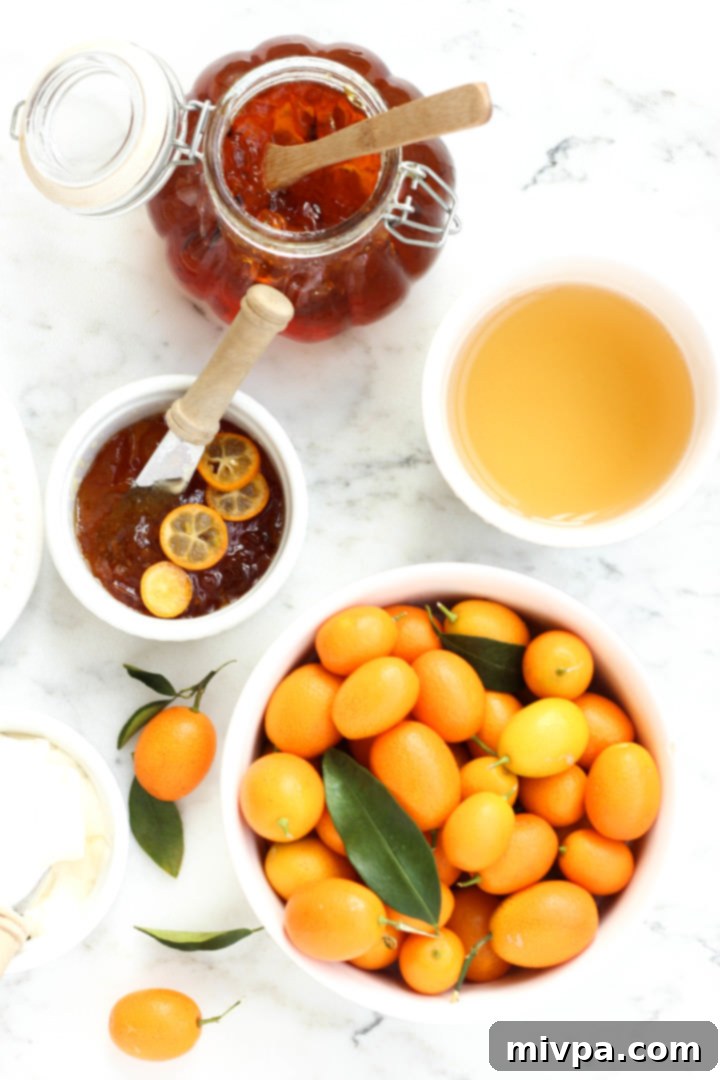Easy Homemade Kumquat Marmalade Recipe: Gluten-Free, Vegan & Pectin-Free
Prepare to be enchanted by this utterly delightful, tangy-sweet kumquat marmalade recipe! It’s not just incredibly delicious, perfect for spreading on your morning toast or dolloping over desserts, but also surprisingly easy to make. The best part? This homemade creation is completely gluten-free and vegan, requiring no added pectin thanks to the kumquats’ natural gelling properties. Whip up a batch or two during kumquat season to savor the bright flavors of winter and spring all year long!
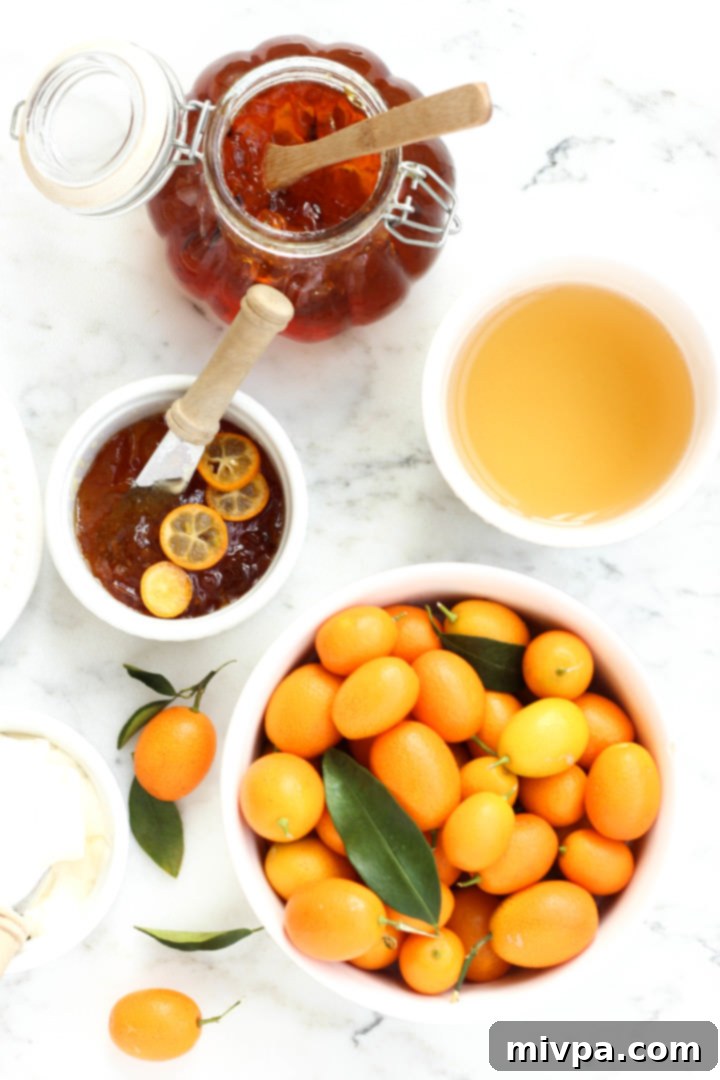
What Are Kumquats? A Guide to This Unique Citrus Fruit
If you’ve never encountered kumquats before, you’re in for a treat! These fascinating citrus fruits are truly a marvel, resembling miniature, oblong-shaped oranges, often no larger than a grape. Their name, “kumquat,” literally translates to “golden orange” in Chinese, perfectly describing their vibrant appearance. Unlike most citrus fruits where the peel is discarded, kumquats boast an edible, bright orange skin that is surprisingly sweet, beautifully contrasting with their tart, sour flesh. This unique characteristic allows you to enjoy the entire fruit, peel and all!
Beyond their delightful flavor, kumquats are a nutritional powerhouse. They are packed with essential nutrients, particularly high in Vitamin C, which is vital for immune health, and fiber, which aids digestion. Snacking on whole kumquats is a fantastic way to boost your daily nutrient intake.
In their natural habitat, kumquat trees can reach impressive heights of up to five meters. However, they are also frequently cultivated as ornamental trees, making it common to find smaller trees adorned with bright orange kumquats for sale as decorative household accents. These resilient plants thrive in warm climates and are native to Southeast Asia. Today, their cultivation has spread to various other countries, including the United States, where they flourish particularly in the sunny regions of Florida and California.
For those eager to get their hands on fresh kumquats, the season typically runs from mid-winter to early spring, specifically from January to June in the US. Keep an eye out for these little golden gems at your local markets during this period – they’re a seasonal delight not to be missed!
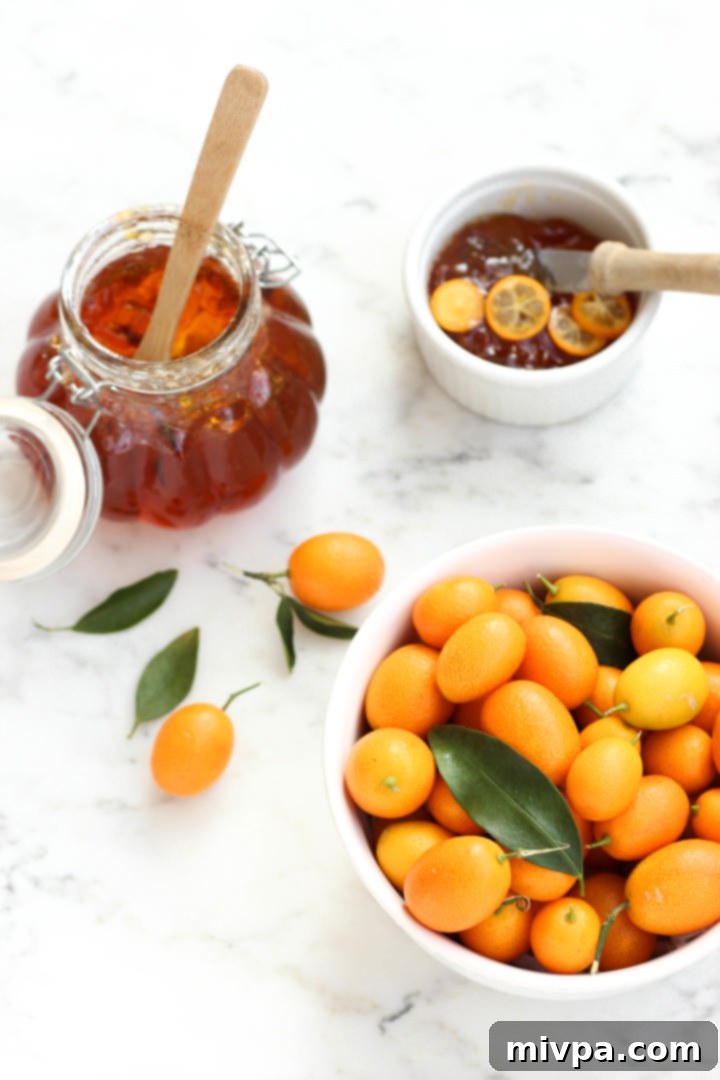
The Unmatched Joy and Benefits of Homemade Everything
There’s an undeniable comfort and immense satisfaction that comes with creating something homemade from scratch. It’s a connection to the process, an understanding of the ingredients, and a deep appreciation for the final product that store-bought items simply cannot replicate. This passion for crafting things myself extends to almost everything in my kitchen.
Whether it’s the therapeutic act of baking homemade bread – watching the dough gracefully double in size, then pulling a fresh, aromatic loaf out of the warm oven – or the mindful preparation of my own non-dairy milks, such as creamy cashew milk or refreshing almond milk, each endeavor brings a unique sense of accomplishment. Even grinding my own flours, like finely textured cashew flour, versatile almond meal, wholesome brown rice flour, or nutritious buckwheat flour, reinforces this feeling. The specific item doesn’t matter as much as the profound joy and sense of capability I gain from knowing I can create something wonderful from simple, basic building blocks.
Given this inclination, making my own jams and marmalades has always been a particular delight. The process of standing at the stove, gently stirring the fruit and sugar, observing their transformation as they integrate into a beautifully thick, gel-like consistency, feels nothing short of magical. It’s a culinary alchemy that preserves the essence of fresh fruit in a jar, ready to brighten any meal.
So, with these gorgeous, fresh kumquats readily available during the vibrant citrus season, it was only natural that I channeled my homemade enthusiasm into crafting this exquisite kumquat marmalade (or kumquat jam, if you prefer that term). It’s a celebration of seasonal produce, a testament to simple ingredients, and a delicious addition to any pantry.
Why This Kumquat Marmalade Recipe Is Your New Favorite
This kumquat marmalade recipe isn’t just another preserve; it’s a testament to simplicity meeting spectacular flavor. Here’s why it stands out and why you’ll love making it:
- Effortlessly Simple Ingredients: You’ll be amazed that only four basic ingredients – kumquats, water, sugar, and lemon juice – are needed to create this gourmet-quality marmalade. With the exception of the star ingredient, kumquats, you likely already have the other pantry staples on hand, making this a truly accessible recipe for anyone wanting to delve into homemade preserves.
- Remarkably Easy to Make: Don’t be intimidated by the idea of making marmalade from scratch. This recipe is designed for ease. It primarily involves simple slicing, gentle stirring, and a bit of patience. In just a little over an hour, you’ll transform humble kumquats into a luxurious, shimmering marmalade. It’s a rewarding process with minimal fuss, perfect for beginners and seasoned preservers alike.
- A Harmonious Blend of Tangy and Sweet: Kumquats are known for their naturally tart, somewhat sour flesh, beautifully complemented by their sweet, edible peel. When combined with sugar in this recipe, the acidity is perfectly balanced, resulting in a wonderfully sweet and tangy flavor profile that is characteristic of the best citrus jams. The thick, luscious consistency and vibrant flavor make this kumquat marmalade absolutely perfect for slathering generously on your morning toast, swirling into yogurt, accompanying cheese, or even, for the truly smitten, enjoying straight from the spoon!
- Naturally Gluten-Free, Vegan, Dairy-Free, and Pectin-Free: One of the most fantastic aspects of this easy kumquat jam recipe is its inclusive nature. It is 100% gluten-free, dairy-free, and vegan. This means that individuals with Celiac disease, gluten sensitivities, or lactose intolerances can indulge without any concerns. Moreover, there’s absolutely no need to add commercial or artificial pectin. The magic lies in the kumquats themselves; their skins are naturally rich in pectin. The freshly squeezed lemon juice acts as a catalyst, reducing the pH level and efficiently extracting this natural fruit pectin, ensuring your marmalade sets beautifully and naturally.
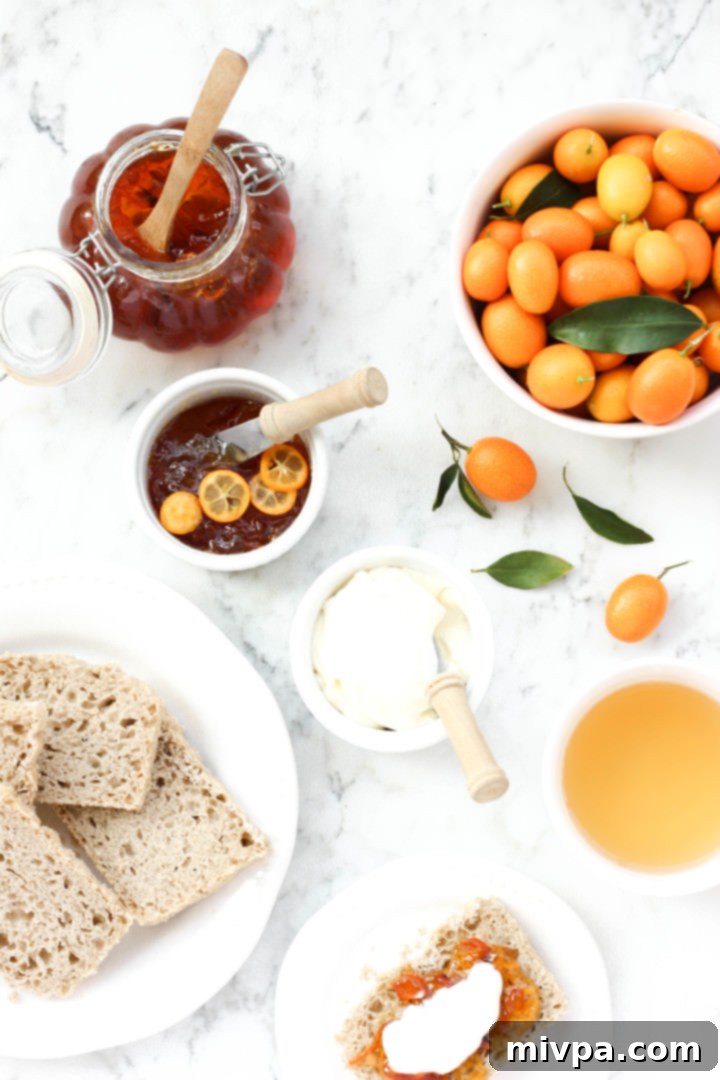
Essential Ingredients for Your Kumquat Marmalade + Helpful Notes & Substitutions
Crafting this delicious kumquat marmalade requires only a few key ingredients, each playing a crucial role in achieving that perfect tangy-sweet flavor and beautiful gel consistency. Here’s a closer look at what you’ll need:
- Kumquats: Naturally, as this is a kumquat marmalade recipe, kumquats are the star ingredient and essential. Look for bright, firm fruits without blemishes. For preparation, you’ll rinse them thoroughly and cut them into thin slices. This exposes the flesh and skin, allowing the flavors to meld and the natural pectin to release. If kumquats are out of season or unavailable, you can explore making other delightful citrus marmalades by substituting with equal amounts of other citrus fruits, such as zesty Meyer lemons, sweet oranges, fragrant mandarins, or even slightly bitter grapefruit. Each will yield a unique but equally rewarding result.
- Water: Water is crucial for simmering the kumquats, helping to soften their rinds and extract their natural pectin. For the purest flavor in your marmalade, I highly recommend using either good quality mineral water or filtered water. Tap water, depending on your location, can sometimes have a strong chlorine taste or other impurities that could subtly alter the delicate flavor of your finished marmalade.
- Sugar: I’ve opted for classic white granulated sugar in this recipe to ensure a bright, clear marmalade that truly lets the kumquat flavor shine. However, if you prefer a slightly deeper, more caramel-like note, feel free to use light brown sugar. Beyond its sweetening properties, sugar plays a vital role in creating the desired gel-like consistency of the marmalade and acts as a natural preservative by inhibiting microbial activity. It’s absolutely essential for both texture and shelf life, so please don’t be tempted to leave it out or drastically reduce the quantity without consulting a tested low-sugar pectin recipe.
- Lemon Juice: For optimal results, freshly squeezed lemon juice is paramount – avoid bottled lemon juice if possible, as its flavor can be less vibrant and its acidity levels less consistent. Lemon juice serves two critical functions in this recipe: it enhances the bright, citrusy flavor profile of the marmalade, and more importantly, it lowers the pH value of the mixture. This acidic environment is crucial for activating and extracting the natural pectin found in the kumquat skins, which is what allows the marmalade to set into that perfect, spoonable consistency.
How to Make Homemade Kumquat Marmalade: A Step-by-Step Guide
Making your own kumquat marmalade is a straightforward and rewarding process. Follow these simple steps to create a delicious batch:
1. Prepare Kumquats and Combine with Water
Begin by thoroughly rinsing your fresh kumquats. Once clean, slice them thinly. You can decide whether to remove the tiny seeds as you slice or later during simmering, but for this recipe, the seeds are often kept in initially as they also contain pectin. Transfer all the thin slices of kumquats into a large, heavy-bottomed pot. Add the measured amount of water to the pot, ensuring the kumquats are mostly submerged. Using a wide pot is beneficial as it allows for quicker evaporation and a faster setting time for your marmalade.
2. Bring to a Boil and Simmer until Tender
Place the pot with the kumquat and water mixture over high heat and bring it to a rolling boil. Once boiling vigorously, reduce the heat to a gentle simmer. Allow the mixture to continue simmering for approximately 45 minutes to an hour, or until the kumquat rinds are very tender and translucent. This crucial step softens the fruit and extracts the natural pectin from the skins, which is essential for the marmalade to set correctly. Stir occasionally to prevent sticking.
3. Add Sugar and Lemon Juice, Then Cook to Gel Stage
Once the rinds are tender, add the measured cups of sugar and the freshly squeezed lemon juice to the pot. Stir well until the sugar completely dissolves. Increase the heat again and bring the mixture back to a rolling boil. Continue to boil, stirring occasionally to prevent scorching, until the marmalade reaches its “gel stage.” This is typically around 220°F (105°C) when checked with a candy thermometer. If you don’t have a thermometer, you can perform a “plate test”: place a small dollop of hot marmalade on a chilled plate, let it cool for a minute, then push it with your finger. If it wrinkles, it’s ready.
4. Skim Foam From Surface
Once the gel stage is reached, carefully remove the pot from the heat. You might notice a layer of foam on the surface of the marmalade. This foam, while harmless, can make your finished marmalade appear cloudy. Use a large spoon or a skimmer to gently remove and discard this foam for a clearer, more aesthetically pleasing final product.
5. Transfer Marmalade to Sterile Jars and Seal
Working quickly while the marmalade is still hot, carefully ladle the mixture into pre-sterilized glass jars (mason jars are ideal). Fill the jars almost to the rim, leaving about a quarter-inch of headspace. Wipe the rims clean to ensure a good seal, then immediately cap with sterile lids and bands, tightening them snugly but not overly tight. As the jars cool completely at room temperature, a vacuum seal will form, indicating proper preservation. You’ll often hear a “pop” as they seal. Once cooled, check the seals by pressing on the center of the lid – it should not flex. Store sealed jars in a cool, dry, dark place. Once a jar of marmalade has been opened, always refrigerate it and consume within one month for best quality.
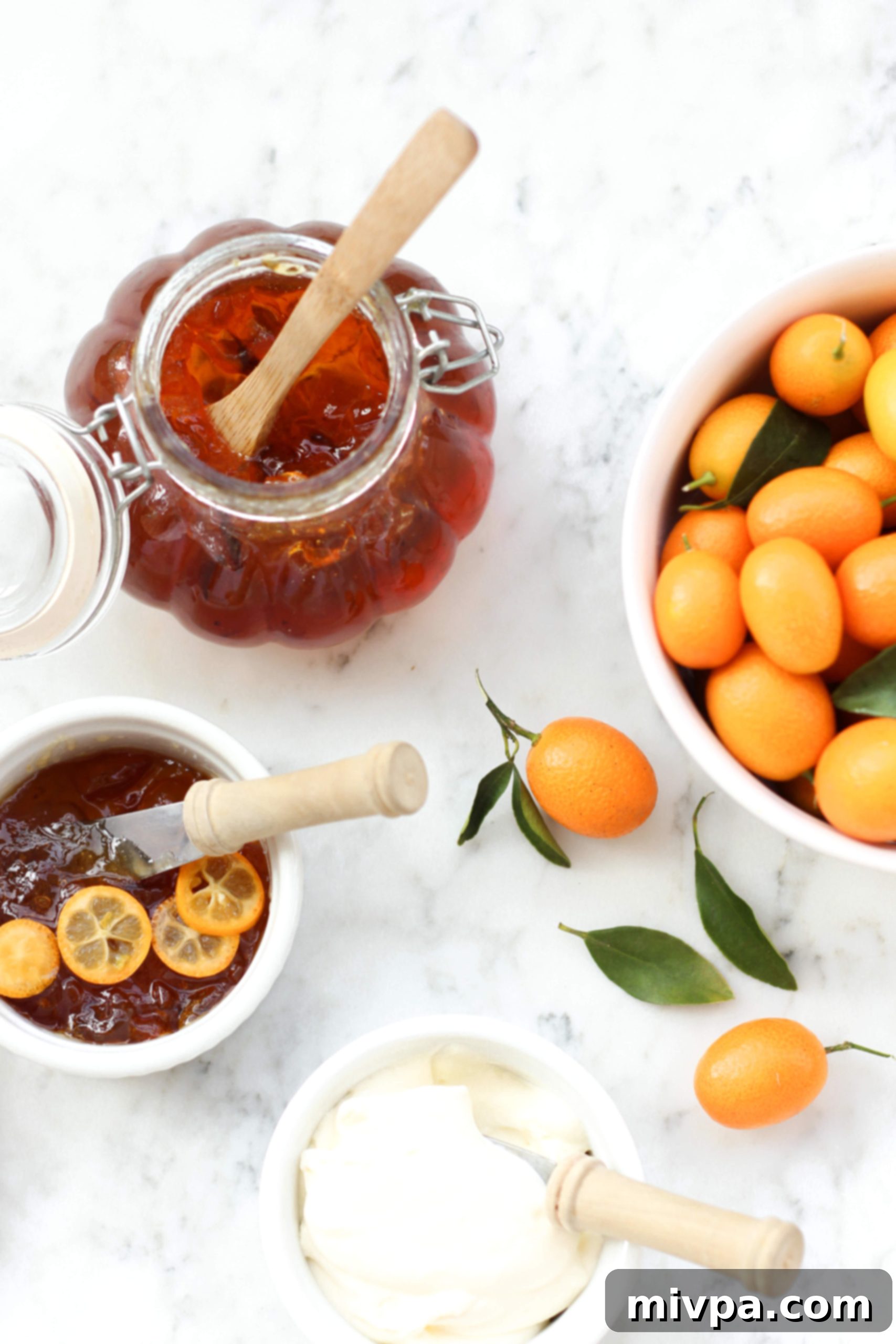
Dish by Dish Tips & Tricks for Perfect Marmalade
Achieving a perfect batch of homemade marmalade is easy with a few expert tips:
- Embrace Citrus Variety: While kumquats are fantastic, this recipe’s principles apply to many citrus fruits. If kumquats aren’t in season or you simply wish to experiment, feel free to substitute them with equal amounts of other citrus. Try zesty Meyer lemons for a fragrant lemon marmalade, sweet naval oranges for a classic orange marmalade, aromatic mandarin oranges, or even tangy grapefruit for a more sophisticated grapefruit marmalade. The key is to use citrus with good natural pectin in their peels.
- Don’t Rush the Simmer: The initial simmering of kumquats and water is crucial. It softens the tough rinds and allows the natural pectin to release. Rushing this step will result in a marmalade that doesn’t set properly, so be patient and ensure the rinds are truly tender.
- Use a Wide, Heavy-Bottomed Pot: A wider pot increases the surface area for evaporation, which means your marmalade will reach its setting point faster. A heavy bottom prevents scorching, which is especially important during the high-heat boiling stage.
- Sterilization is Key: For marmalade that keeps well, ensure your jars, lids, and any utensils that touch the hot marmalade are thoroughly sterilized. You can do this by boiling them, running them through a hot dishwasher cycle, or heating them in an oven. Proper sterilization prevents spoilage.
- Test for Set Point Accurately: While a candy thermometer is the most reliable tool (aim for 220°F or 105°C), the cold plate test is also effective. Keep several small plates in the freezer. When you think the marmalade is ready, spoon a small amount onto a cold plate, wait 30 seconds, then push it with your finger. If the surface wrinkles, it’s set.
- Mind the Foam: Skimming off the foam isn’t just for aesthetics. Excessive foam can trap air, which might affect the shelf life and clarity of your marmalade. A tiny knob of butter added during the last 5 minutes of cooking can also help reduce foam.
Frequently Asked Questions About Kumquat Marmalade
Proper storage is essential for preserving your homemade kumquat marmalade. I highly recommend storing it in thoroughly sterilized glass jars or mason jars. For optimal shelf life, sealed, unopened jars of homemade jam should be stored in a cool, dry, and dark place, away from direct sunlight. When stored correctly, your marmalade can be enjoyed for up to 12 months after making it. Once a jar of marmalade has been opened, it must be stored in the refrigerator. After opening, aim to consume it within 1 month for the best taste and quality.
Absolutely, yes! One of the most unique and delightful characteristics of kumquats is their thin, sweet, and entirely edible skin. Unlike other citrus fruits, the skin of a kumquat provides a pleasant sweetness that beautifully counteracts the sourness of its flesh, creating a balanced flavor experience when eaten whole. For this marmalade recipe, there’s no need to peel the kumquats at all. As the kumquats cook during the marmalade-making process, their skins will soften even further, becoming wonderfully tender and infusing the preserve with their aromatic oils and natural pectin. Embrace the whole fruit!
Pectin is a naturally occurring gelling agent found in the cell walls of many fruits, acting as a soluble fiber. It is particularly concentrated in the skins and seeds of citrus fruits, including kumquats. In jams and marmalades, pectin’s role is crucial: when heated with sugar and acid (like lemon juice), it forms a complex molecular network that traps liquid, causing the mixture to thicken and “set” into a gel-like consistency. Lowering the pH value of the jam or marmalade with acid (such as lemon juice) makes it easier for the pectin molecules to bind together, ensuring a successful set without the need for additional commercial pectin.
When choosing kumquats for your marmalade, look for fruits that are bright orange, firm to the touch, and feel heavy for their size. Avoid any kumquats that appear dull, soft, shriveled, or have visible blemishes. A good kumquat will have a fragrant, citrusy aroma. Since the skin is essential for both flavor and pectin in this recipe, healthy, unblemished skins are key.
While it’s tempting to reduce sugar for health reasons, it’s important to understand that sugar plays a critical role in marmalade making beyond just sweetness. It contributes to the setting of the marmalade (working with pectin and acid) and acts as a natural preservative. Drastically reducing the sugar content in this recipe without using a specific low-sugar pectin product could result in a marmalade that doesn’t set properly and has a significantly reduced shelf life. For best results with this pectin-free recipe, I recommend sticking to the stated sugar amount.

Other Homemade Jams and Marmalade Recipes You’ll Love:
If you’ve enjoyed making this kumquat marmalade, you’ll surely love exploring these other delightful homemade preserve recipes. Each offers a unique flavor and the same satisfying experience of making something delicious from scratch:
- Easy Plum Jam: A vibrant, sweet, and juicy jam perfect for toast or desserts.
- Easy Apricot Jam (Gluten-Free, Vegan): Captures the delicate sweetness of fresh apricots in a simple, wholesome spread.
- Mixed Berry Chia Seed Jam (Gluten-Free, Vegan): A healthier, quick-setting jam packed with the goodness of berries and chia seeds.
- 20-Minute Homemade Cranberry Sauce: Not just for holidays, this tangy sauce is a fantastic condiment year-round.
More Gluten-Free Basics and Recipes You’ll Enjoy:
Beyond delicious preserves, maintaining a gluten-free diet opens up a world of culinary creativity. Here are a few more foundational gluten-free recipes to inspire your cooking and baking:
- Easy 10-Minute Blueberry Glaze (Gluten-Free, Vegan)
- 5-Minute Gluten-Free Chicken Marinade (3 Ways!)
- Easy Homemade Chicken Stock (Gluten-Free, Dairy-Free)
- Easy Gluten-Free Apple Pie Filling (Vegan)
P.S. If you try this incredible easy kumquat marmalade recipe, I’d absolutely love for you to leave a star rating below, and/or a thoughtful review in the comment section further down the page. Your feedback is always deeply appreciated and helps others discover this delightful recipe! Be sure to check out my entire Recipe Index for all the delicious recipes on the blog. You can also follow me on Pinterest, Facebook or Instagram! Sign up for my Email List to get fresh, inspiring recipes delivered straight to your inbox each week!
Print

Easy Kumquat Marmalade
5 Stars 4 Stars 3 Stars 2 Stars 1 Star
5 from 3 reviews
Author: felicia | Dish by Dish
Total Time: 1 hour 10 minutes
Yield: 2 jars
Diet: Vegan
Description
This tangy-sweet kumquat marmalade recipe is delicious and perfect for spreading on toast or even eating by the spoonful. Also incredibly easy to make, and totally gluten-free, vegan, and no added pectin is required either! Make a batch or two to enjoy all year round!
Ingredients
Units
Scale
- 4 cups kumquats, rinsed and cut into thin slices
- 2 cups filtered water
- 2 cups white sugar
- 1/4 cup fresh lemon juice
Instructions
- Combine Kumquats and Water: Combine the sliced kumquats in a large, heavy-bottomed pot with the water.
- Bring to a Boil and Simmer: Bring the kumquat-water mixture to a rolling boil over high heat, then reduce the heat to a simmer. Allow to simmer for about 45 minutes to 1 hour, or until the rinds are very tender and translucent.
- Add Sugar and Lemon Juice, Cook to Set: Add the sugar and lemon juice to the pot. Stir until the sugar dissolves. Bring to a rolling boil again, stirring occasionally, until a gel stage is reached (approximately 220°F, or 105°C, on a kitchen thermometer). You can also use the cold plate test.
- Skim Foam From Surface: Remove the pot from heat and use a spoon to carefully skim any foam from the surface of the marmalade for a clearer finish.
- Transfer to Sterile Jars and Seal: Ladle the hot marmalade into sterile jars, leaving about 1/4 inch headspace. Wipe rims clean and seal immediately with sterile lids. Let jars cool completely at room temperature to form a vacuum seal. Refrigerate marmalade once a jar has been opened.
Notes
Kumquats: While kumquats are essential for this specific marmalade, you can substitute with other citrus fruits like oranges, mandarins, or grapefruit for different types of homemade marmalade. Ensure they are fresh and firm.
Water: For the best and cleanest flavor profile, using mineral water or filtered water is recommended. This helps avoid any potential chlorine taste from tap water impacting your delicious marmalade.
Sugar: White granulated sugar is used for a bright, clear marmalade. However, if you prefer a subtle hint of caramel and a deeper color, feel free to use light brown sugar. Remember, sugar is vital for both setting and preserving the marmalade, so do not omit or significantly reduce it.
Lemon Juice: Always opt for freshly squeezed lemon juice over bottled varieties. Fresh lemon juice provides superior flavor and its natural acidity is crucial for activating the pectin in the kumquats, ensuring your marmalade sets beautifully.
- Prep Time: 10 mins
- Cook Time: 1 hour
- Category: Marmalade
- Method: Stovetop
